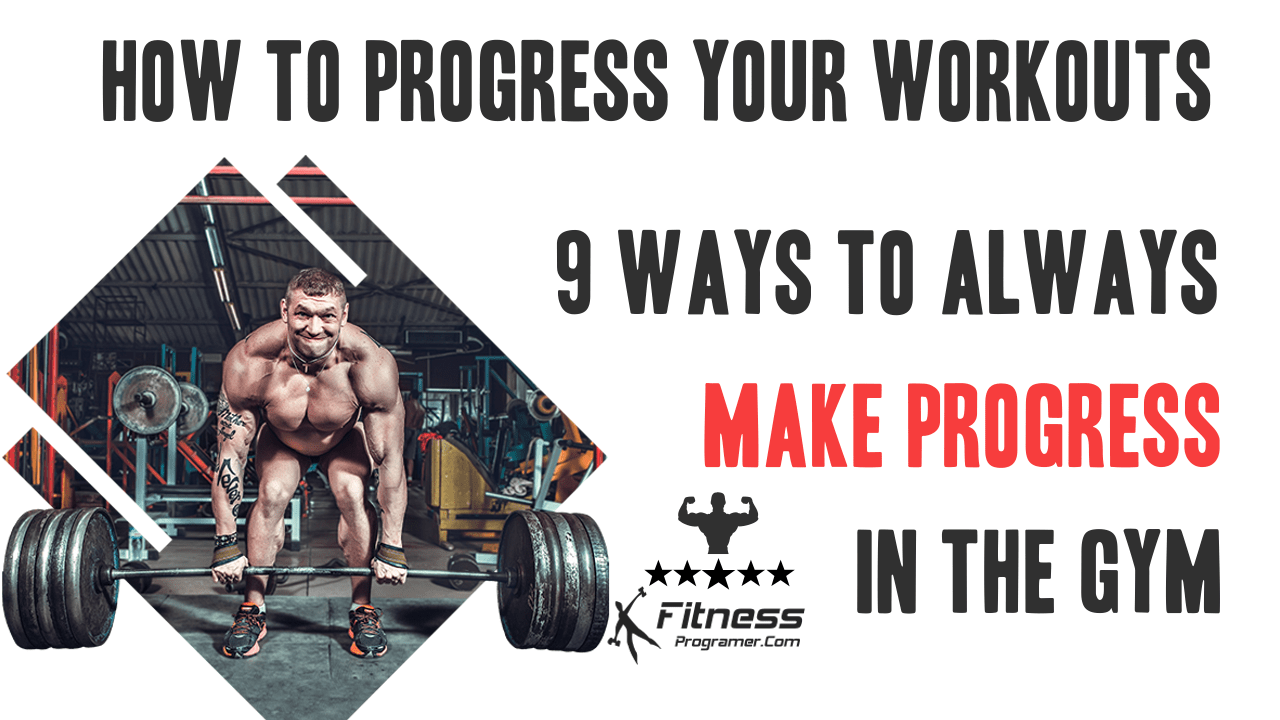Contents
You’re hitting the gym daily, putting in a good amount of time and effort. As such, you want to ensure that you’re moving ahead as quickly and efficiently as possible.
The last thing you want to do is waist your time and be looking at yourself one year from now, in virtually the same place as you are now.
Sadly, this is how the story goes for many people. Unless you are taking smart steps, plateaus happen and in some cases, they can be the thing that throws you completely off track as far as your program is concerned.
Most people will only sustain motivation for so long when progress isn’t seen before they fall off the bandwagon entirely.
So, let’s go over nine strategies that you can use to ensure that you are always forging onward, seeing the results that you desire.
9. Schedule Periodic Sessions With A Trainer
If you’ve been training for a while already, you might feel like you know your stuff and don’t need to be consulting with a personal trainer. You can find your own workout routine and follow it – no problems there.
But, sometimes it really does help to have a fresh set of eyes on the situation. Scheduling a workout with a trainer once every 2-4 weeks can do just the trick to help get you motivated and seeing results.
Sometimes that trainer may spot places where you’re going wrong. For instance, perhaps you’re using poor form on one of the lifts you’re doing which is likely to rule out you seeing any results.
Or, maybe you are utilizing an imbalance of exercises, training chest more than back without even realizing it.
A trainer can overlook this and make any recommendations as necessary. Even the most experienced individuals often have trainers by their side, so don’t feel bad if you choose to get one.
8. Start Tracking
Next, it’s also a good idea to start tracking your sessions daily. Write down what you’re doing for sets, reps, and weight lifted.
If you don’t track this, it’s impossible to remember what you did last workout so that you can ensure you beat it.
Progress is going to occur by you overloading the body. This means doing more than what you’ve done before. The minute you simply maintain the status quo – doing the same amount that you did last workout – is the minute that you will start hitting that plateau.
The change doesn’t need to be much. It could be as simple as doing one extra rep on the bench press or adding a five pound plate to your leg press. Either way, you will be seeing progress if you make this change.
Tracking is also a great strategy as it’ll allow you to look back over time at what workouts you have done and what’s worked best for your body.
Using this information, you can then better structure the workouts you plan for yourself into the future.
7. Try New Exercises Weekly
The next quick tip to help ensure constant success is to try new exercises regularly. If you’ve been hitting the gym and have done the same workout routine for the last 20 times, it doesn’t take much to realize that not only will your body be bored, but you’ll likely be bored as well.
This is a worst case scenario because as your body adapts to the workout routine, it’ll stop responding and progressing further.
Likewise, as you get mentally bored, you’ll stop putting in maximum effort and instead, just ‘check out’ as you do the workout mindlessly.
By adding a new exercise into the mix, you regain focus and will stay committed to lifting at full intensity.
This doesn’t need to be a big change here either. It can be as simple as changing your grip or stance. For instance, rather than doing a regular stance leg press, try using a wide stance.
Or, rather than doing a normal bent over row, try a reverse grip. Little changes like this can really get your muscles sitting up and responding, allowing you to see optimal results.
Try and add one new exercise (or adjust an exercise you are already doing) at least once per week. It’ll keep your workout that much more interesting.
6. Set Daily Goals
Setting daily goals is also a smart plan for anyone who wants to see ongoing results. By setting a daily goal – something that you want to achieve that workout, you’ve now just given that workout a purpose.
If you go on to achieve that goal, you’ll first give yourself a huge boost in confidence. You’ll have accomplished what you set out to and this will drive you forward, giving you the feeling that with hard work, you can accomplish that long term goal as well.
Second, it keeps you focused on the workout at hand. When you look at one workout in the grand scheme of around a hundred or so to reach that long term goal, it may not seem like that big of a deal. This can breed mediocre effort. When that single workout has a mission though, you change your approach.
You’ll now be focused on that session in particular, making sure that you’re giving maximum effort.
Note that this goal should be something that you could easily accomplish with a conscious effort and should be in line with the long term goal you are striving to obtain.
Slowly but surely, as you reach these daily goals, that long term goal will get that much closer.
5. Prioritize Rest
Next, you also want to make sure that you’re prioritizing rest. This may sound silly as taking time away from the gym doesn’t seem like working towards your gym goals, but it is.
If you aren’t resting enough in your program, your muscles won’t be getting the chance they need to grow back stronger than they were before, which then means you’ll start hitting a strength plateau.
In fact, if you rest too little, you might actually see yourself getting weaker as your body simply can’t keep up with the demands you’re placing upon it.
It’s a good idea to constantly be monitoring for overtraining syndrome and assessing your overall rest to work balance. If you’ve been feeling tired in your workouts for more than a couple days, take a few days off. Realize that by doing so, you will only move forward, not backward.
Rest is a vital component of any good workout program.
4. Periodize Your Program
The next step to seeing ongoing progress is to make sure that you’re periodizing your workout program. This means focusing on working towards certain goals at certain time periods of the year.
For instance, you might have a muscle building phase during the colder winter months and then come spring, move into a fat loss phase.
Or, you might look at things from a performance perspective. During one segment of the year, you are focusing purely on strength generation. Then, 8-12 weeks later, you are focusing on muscle size. Then, in another few months, you focus on speed and agility.
Dividing up your year like this ensure that you are changing your program around, staying focused, and improving all areas of your fitness and physique.
You can do this periodization over a year long period or a shorter time frame if you prefer. Set it up before you begin your workout program and you’ll always know precisely where you are in the protocol.
3. Switch Workouts Every 8-12 Weeks
Speaking of periodization, this brings us to the next point, changing around your workouts. You should never stay on one workout program for an extended period of time as that in itself can mean that you move into a progress plateau.
Whether you are changing your goal set or not, you should be trying a new workout program every 8-12 weeks of continual training.
This will keep both your mind as well as your body feeling fresh and ensure that you continue to see ongoing progress.
Try and stretch out a program until you no longer are seeing results – or progress is much slower than it initially was and then make the change to a completely new program.
2. Get A Training Buddy
Having a training buddy is the next strategy to ensure ongoing progress. Having someone there to help push you during each workout session can help you go that extra mile, which will lead to superior results.
Ideally your training buddy should be at the same fitness level as you or slightly higher so they will continue to inspire you to achieve more for yourself.
A training buddy will also help you stay more consistent with your workout program as well, which can also reduce the chances that you start skipping workouts, which would without a doubt lead to stagnant progress.
1. Monitor Nutrition
Finally, make sure that you are constantly monitoring your nutrition status as well. Don’t forget that if you aren’t eating right, it’ll be impossible to see the results that you’re hoping for, especially if muscle building or fat burning are in your goal set.
Good nutrition will help your body recover, perform to its best, and experience the body composition changes that you’re after.
It really is just as important as what you are doing in the gym, so if you start to see your gym performance falter, it might be time to take a closer look at your nutrition to see if something is off there.
The two go hand in hand, so make sure that you aren’t neglecting one. If you don’t know how to set up a good nutrition plan, make sure that you get the advice from someone who does. For long term success, it’s something you can’t miss out on.
So keep these quick points in mind to help you avoid that dreaded progress plateau and go on to reach all the goals that you’ve set for yourself. Work smart, train hard, and stay focused. If you do, you can feel confident you’re doing everything you possibly can be.



